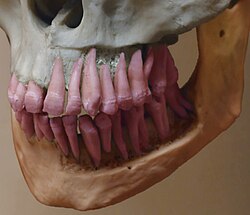
Back ناتئ سنخي Arabic Processus alvéolaire du maxillaire French Fogmedernyúlvány Hungarian Wyrostek zębodołowy Polish Processo alveolar Portuguese Альвеолярный отросток Russian
| Alveolar process | |
|---|---|
 Human jaws with anterior (frontal) portion of alveolar processes cut away towards right | |
| Details | |
| System | Skeletal |
| Identifiers | |
| Latin | os alveolaris |
| TA98 | A02.1.12.035 |
| TA2 | 791 |
| FMA | 59487 52897, 59487 |
| Anatomical terms of bone | |
The alveolar process (/ælˈviːələr, ˌælviˈoʊlər, ˈælviələr/)[1] or alveolar bone is the thickened ridge of bone that contains the tooth sockets on the jaw bones (in humans, the maxilla and the mandible).[2] The structures are covered by gums as part of the oral cavity.
The synonymous terms alveolar ridge[3] and alveolar margin are also sometimes used more specifically to refer to the ridges on the inside of the mouth which can be felt with the tongue, either on roof of the mouth between the upper teeth and the hard palate or on the bottom of the mouth behind the lower teeth.[4]
- ^ Wells JC (2008). Longman Pronunciation Dictionary (3rd ed.). Longman. ISBN 9781405881180.
- ^ Bath-Balogh & Fehrenbach 1997, p. 195.
- ^ "Definition of ALVEOLAR PROCESS". www.merriam-webster.com. Retrieved 9 March 2022.
- ^ Phonetics at the Encyclopædia Britannica Accessed: 12 September 2018.
© MMXXIII Rich X Search. We shall prevail. All rights reserved. Rich X Search